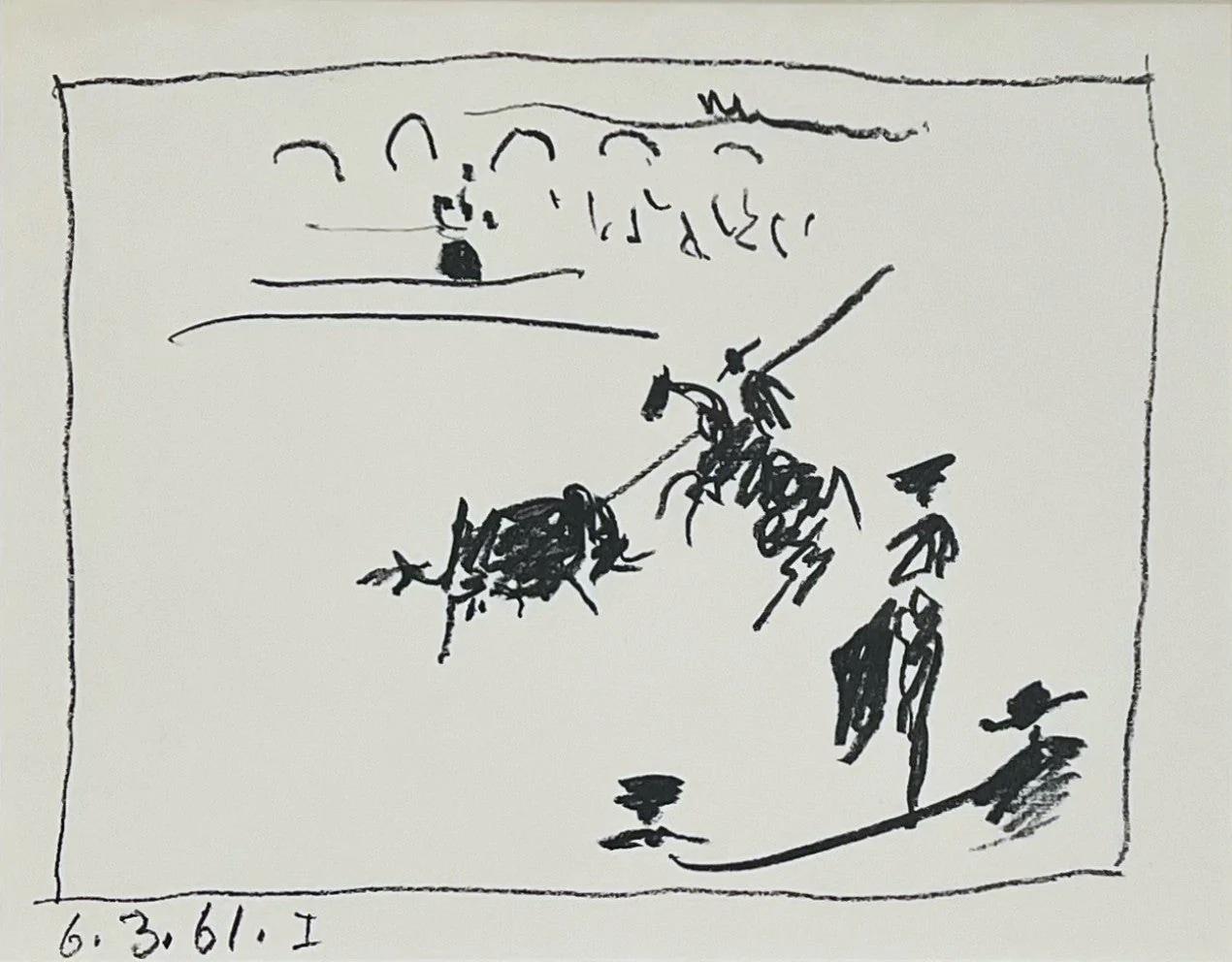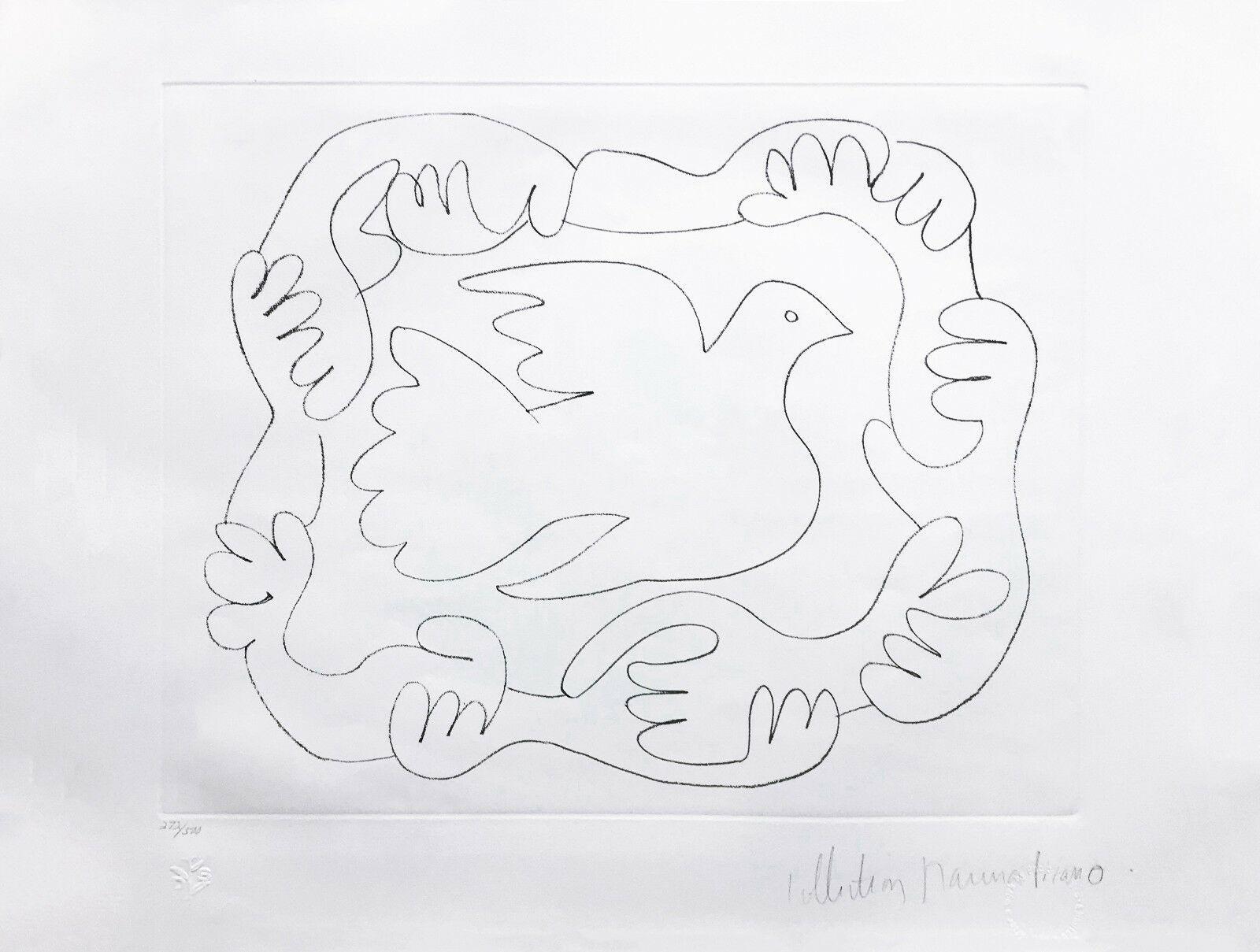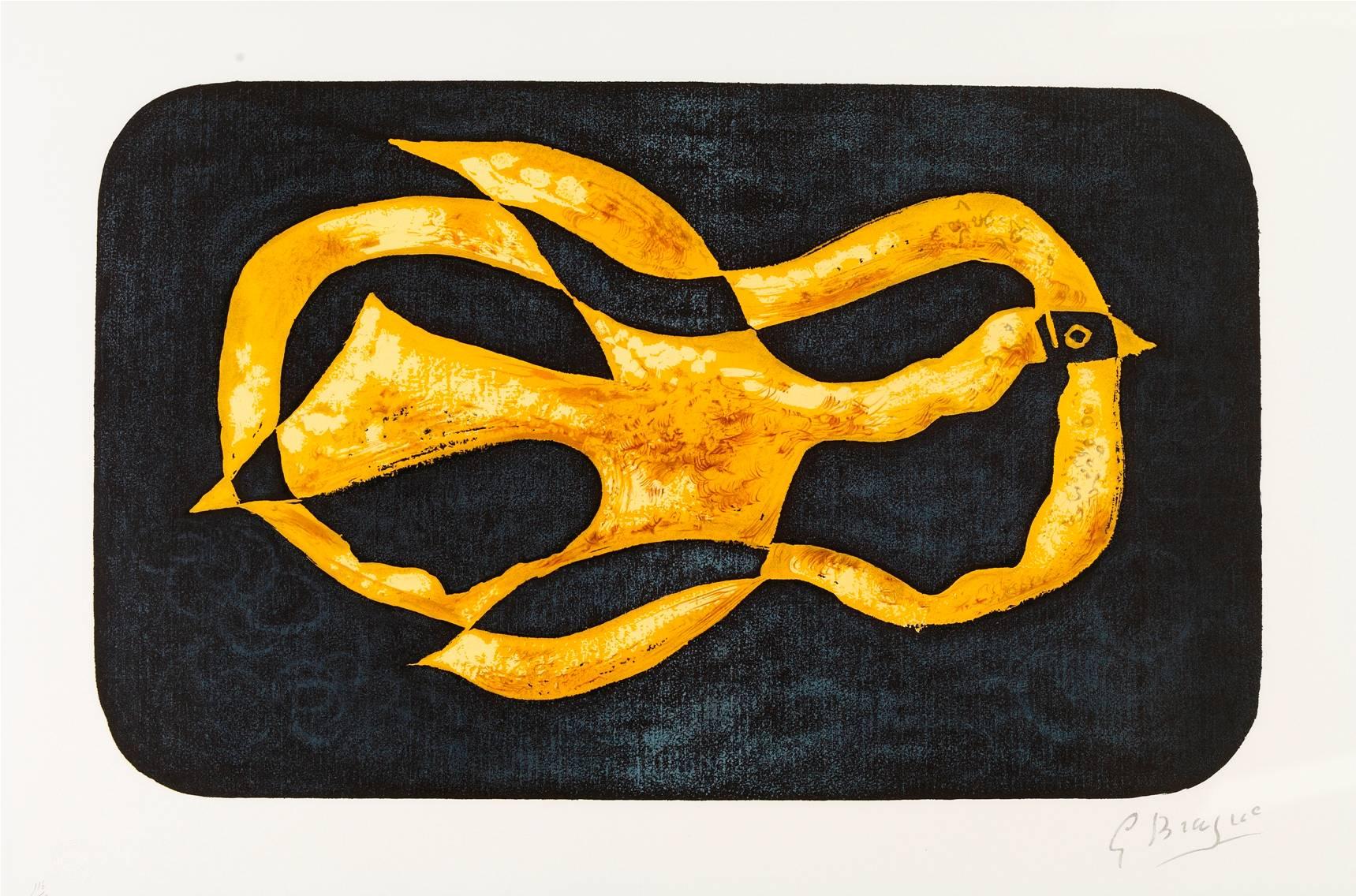Georges BraqueThe Equinox - French Artist - Hand Signed Lithograph - Cubism, Fauvism
About the Item
- Creator:Georges Braque (1882 - 1963, French)
- Dimensions:Height: 21.26 in (54 cm)Width: 31.7 in (80.5 cm)
- More Editions & Sizes:54 x 80.5; Edition of: 75Price: $8,000
- Medium:
- Movement & Style:
- Period:
- Condition:Very good condition. The sheet with pale toning and handling creases in the margins. Remnants of hinging tape, verso.
- Gallery Location:London, GB
- Reference Number:1stDibs: LU18011537082
Georges Braque
Georges Braque was born in Argenteuil, France, in 1882. Braque lived much of his childhood and young adult life in Le Havre. He attended night classes at the art school from 1897–99 and then moved to Paris, where he obtained his license as a master decorator. From 1905–06, after studying at École des Beaux-Arts in Paris and having been influenced by the works of Henri Matisse, he began to paint in the way of Fauvism by using bright colors and taking advantage of the freedom of the composition. Paysage à L'Estaque (1906) was one of the prominent works of art made at this time.
The year 1907 was a significant time in Braque's development, wherein he visited the retrospective on Paul Cézanne and he came into contact with Picasso, who was very engrossed in the realization of Les Demoiselles d'Avignon at the time. At this point, Braque began nurturing a considerable interest in primitive art. After the First World War, Braque worked autonomously and developed a more personal style, which was characterized by vivid colors and textured surfaces. Braque painted still life, interior views, and ocean scenes. The Ateliers (1948–55) and Birds (1955–63) series were painted during this period. In 1948, he obtained his first award for painting at the XXIV Biennial in Venice.
- ShippingRetrieving quote...Ships From: london, United Kingdom
- Return PolicyA return for this item may be initiated within 3 days of delivery.
- Goat Skull on the TableBy (after) Pablo PicassoLocated in London, GBPABLO PICASSO 1881-1973 Málaga 1881-1973 Mougins (Spanish) Title: Goat Skull on the Table Crâne de chèvre sur la table, 1953 Technique: Hand Signed and ...Category
1950s Cubist Animal Prints
MaterialsAquatint
- Deer Les cerfs - Chinese Abstract Animals DeersBy Zao Wou-KiLocated in London, GBThis lithograph in colours is hand signed in pencil by the artist "Zao Wou-Ki" in Chinese and Pinyin at the lower left margin. It is also hand numbered in pencil from the edition of ...Category
1950s Abstract Animal Prints
MaterialsLithograph
- The Red Rooster | Le coq rouge - Circus French RussiaBy Marc ChagallLocated in London, GBThis original lithograph in colours is hand signed in pencil by the artist "Marc Chagall" at the lower right margin. It is also numbered in pencil from the edition of 200, at the low...Category
1950s Animal Prints
MaterialsLithograph
- Geography Book (Félicité's only view from abroad)By David HockneyLocated in London, GBThis original etching and aquatint is hand signed in pencil by the artist "David Hockney" at the lower right margin. It is dated in pencil “74” [1974] next to the signature. It is a...Category
1970s Animal Prints
MaterialsAquatint, Etching
- The Bull Der Stier - German Expressionism Bull Der SturmBy Franz MarcLocated in London, GBThis woodcut by Franz Marc is hand signed in pencil by the artist’s wife "Maria Marc", verso. The paper also bears the violet inkstamp, verso "Handdruck vom Originalholzstock bastaet...Category
1910s Expressionist Animal Prints
MaterialsWoodcut
- Félicité Sleeping with Parrot, from: Illustration for a Simple Heart of GustaveBy David HockneyLocated in London, GBThis original etching and aquatint is hand signed in green pencil by the artist "Hockney" at the lower right margin. It is also hand signed in pencil from the edition of 100, at the...Category
1970s Animal Prints
MaterialsAquatint, Etching
- Elegant flight - Lithograph - Printed signatureBy (after) Georges BraqueLocated in Paris, FRGeorge BRAQUE Elegant flight Lithograph on vellum after a painting Printed signature in the plate 399 copies unnumbered On Arches vellum 18 x 23" (45 x 58 cm) Excellent conditionCategory
Late 20th Century Cubist Animal Prints
MaterialsLithograph
- La Pique (I), from A Los Toros Avec PicassoBy Pablo PicassoLocated in Washington, DCArtist: Pablo Picasso Medium: Transfer lithograph Title: La Pique (I) Portfolio: A Los Toros Avec Picasso Year: 1961 Framed Size: 16 3/4" x 19 1/4" Image Size: 8" x 10" Sheet Size: 9...Category
1960s Cubist Animal Prints
MaterialsLithograph
- ETUDES DES MAINS ET COLOMBEBy (after) Pablo PicassoLocated in Aventura, FLSelected from the personal collection inherited by Marina Picasso, Pablo Picasso's granddaughter. After Pablo Picasso's death, his granddaughter Marina authorized the printing of t...Category
1980s Cubist Animal Prints
MaterialsLithograph, Paper
- PIGEONSBy (after) Pablo PicassoLocated in Aventura, FLSelected from the personal collection inherited by Marina Picasso, Pablo Picasso's granddaughter. After Pablo Picasso's death, his granddaughter Marina authorized the printing of t...Category
1980s Cubist Animal Prints
MaterialsPaper, Lithograph
- After Georges Braque - Antiborée - LithographLocated in Collonge Bellerive, Geneve, CHLithograph after Georges Braque. Signed in the plate Edition of 150 Dimensions: 76 x 117 cm Bibliography: « Les Métamorphoses de Braque» of Heger de Loewenfeld and Raphaël de Cuttoli , Editions FAC, Paris, 1989. In 1961 Georges Braque decided with his laidary friend Heger de Loewenfeld to pick up certain of his works to in order to create artworks, this beautiful litograph is one of them. Héméra in the Mythology: In Greek mythology Hemera was the personification of day and one of the Greek primordial deities. She is the goddess of the daytime and, according to Hesiod, the daughter of Erebus and Nyx (the goddess of night). Hemera is remarked upon in Cicero's De Natura Deorum, where it is logically determined that Dies (Hemera) must be a god, if Uranus is a god. The poet Bacchylides states that Nyx and Chronos are the parents, but Hyginus in his preface to the Fabulae mentions Chaos as the mother/father and Nyx as her sister. She was the female counterpart of her brother and consort, Aether (Light), but neither of them figured actively in myth or cult. Hyginus lists their children as Uranus, Gaia, and Thalassa (the primordial sea goddess), while Hesiod only lists Thalassa as their child. The father of Cubism Three Cubist that distinguishes art historian periods were initiated and developed by Georges Braque: The Cubist Cézanne (1907-1909), Executive (1909-1912) and synthetic (1912-1922). Post-Impressionist and fawn, Braque no longer adheres to the contingency of a decorative way or the other. Cézanne’s paintings exhibited at the Grand Palais during the retrospective of 1907 are a revelation: Cézanne sought and invented a pictorial language. In his footsteps, Braque went to the South with the reasons of the Master. He returned with Estaque landscapes and surprising Ciotat it keeps Cezanne geometric model and retains the “passages” continuity from one surface to another to create the sensation of “turning around” of the object represented. But he wants to go after the consequences of the vision of Cezanne. In his paintings Houses in L’Estaque (1908) it simplifies the volumes of houses, neglects detail by removing doors and windows: the plastic rhythm that builds the table. Large Nude , a masterpiece of the period, can be considered the first work of Cézanne cubism . Systematizing and deepening Braque discoveries open the door analytical cubism. In 1909, his painting became more cerebral than sensual. The pattern is recreated in the two-dimensionality of the canvas, leaving aside any illusionistic perspective. In Still Life with Violin, objects are analyzed facets according to their characteristic elements, each facet referring to a particular view of the object. There are so many facets of points selected view: Table reflects the knowledge of the object and the ubiquity of the eye. Moreover, Braque is looking for the essence of the objects in the world rather than their contingency, which explains the absence of light source and use of muted colors (gray, ocher), contingent aspects of the object . But formal logic has stepped facets, erased any anecdote to the object and ultimately led to his painting a hermetic more marked on the edge of abstraction (see the series of Castle Roche-Guyon ). Braque, anxious to keep the concrete and refusing at all costs that the logic of Cubism takes the paintings to abstract, reintroduced signs of reality in his paintings in 1912 marks the beginning of Synthetic Cubism. Historians speak of “signs of real” rather than reality because what interests Braque, this is not to put reality into a table, but to create a painting which, by its language, refers to the real. To do this, he invented two major techniques XX th century inclusions and contributions. The inclusions consist of painting objects that have no real depth, materials (wallpaper in Nature morte aux playing cards faux wood is a pictorial inclusion) or letters (calligraphic inclusion in Portuguese ), made first brush and a few months later stencil. Contributions are defined in contrast with the collage on canvas of foreign materials: glued or sand paper, sawdust, etc.. Regarding the collages, Braque used for the first time in September 1912 a piece of adhesive paper imitating faux wood Compote...Category
1950s Cubist Animal Prints
MaterialsLithograph
- NATURE MORTE A LA PALETTE ET A LA TETEBy (after) Pablo PicassoLocated in Aventura, FLSelected from the personal collection inherited by Marina Picasso, Pablo Picasso's granddaughter. After Pablo Picasso's death, his granddaughter Marina authorized the printing of t...Category
1980s Cubist Animal Prints
MaterialsLithograph, Paper





